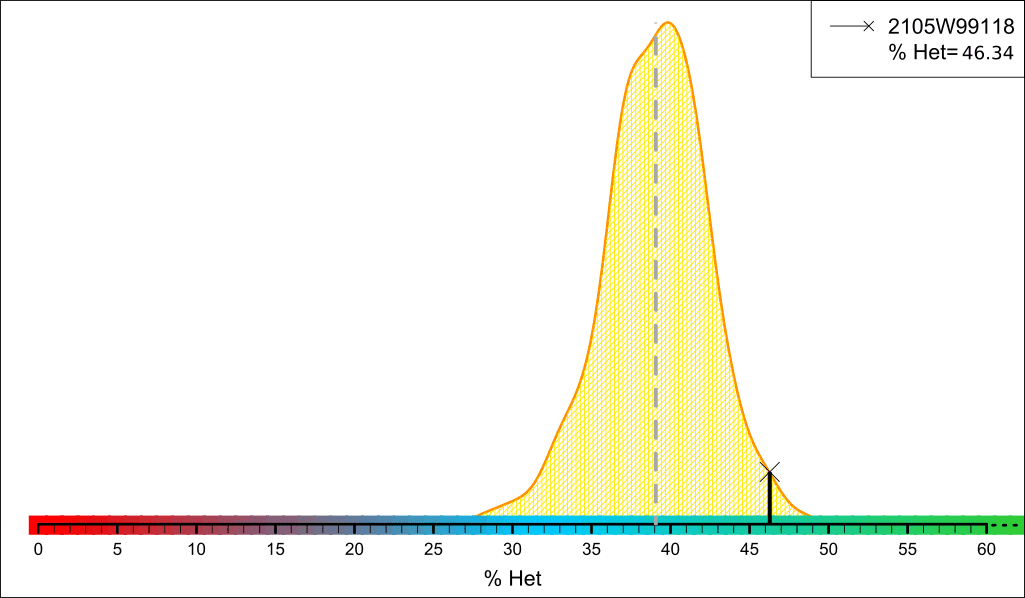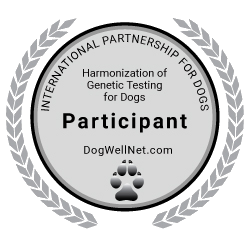DNA-Profiling
Webflyer: "Premium SNP DNA profile (ISAG 2020)"
Premium SNP DNA profile (ISAG 2020)
The Premium SNP DNA-profile (ISAG 2020) is your animal's genetic fingerprint. It cannot be manipulated or destroyed, remains unchanged for a lifetime and allows unambiguous identification of the individual. All DNA-profiles are stored in our DNA database, thus ensuring continuous availability. The Premium SNP DNA-profile (ISAG 2020) follows the recommended ISAG (International Society for Animal Genetics) guidelines from 2020 by analyzing 230 SNPs (single nucleotide polymorphisms) and enables international comparability between laboratories. Each SNP marker describes a specific location on the DNA. Test reliability and exclusion probabilities for parentage analysis are well over 99.99%. The Premium SNP DNA profile (ISAG 2020) also has the potential to solve parentage cases where only one parent is available (breeds on request) and furthermore allows an analysis of the genetic diversity (heterozygosity) of a dog with breed-specific evaluation (for clubs on request).
Please note: Premium SNP DNA-profile (ISAG 2020) and Classic STR DNA profiles (ISAG 2006) are not compatible and cannot be used simultaneously within the same parentage analysis.
Species
dog
Breed
all breeds
Test duration
4-6 weeks after arrival of the sample in the lab
Genetic variability (heterozygosity)
Findings – an example

This graph shows the genetic variability (heterozygosity) of your animal. Heterozygosity describes the percentage of genetic markers (SNPs) for which your dog has inherited different variants from its mother and its father. According to current scientific knowledge, dogs with a high degree of heterozygosity within a breed are less often affected by inbreeding than dogs with a low degree of heterozygosity. For the calculation of heterozygosity, we use the genetic fingerprint (the Premium SNP DNA profile) and hundreds of other genetic markers in your dog’s DNA. In the graph, your dog is marked with a cross and a black solid line. Once LABOKLIN has examined a sufficiently large reference population for your breed, you can see the genetic variability of the entire breed population as an area shaded in orange. The mean value of the breed is marked as a grey dashed line. Small population sizes and inbreeding can decrease the heterozygosity of a breed. When breeding, animals with a high degree of heterozygosity within their breed might thus contribute to the preservation of the breed’s genetic diversity. However, please note that heterozygosity cannot be used to draw any conclusions about individual factors such as genetic diseases or characteristics like coat colour. Maintaining genetic variability can be a building block in responsible dog breeding, but it should not be viewed in isolation.
FAQs on Genetic Variability (Heterozygosity)
What is genetic variability (heterozygosity)?
Each genetic trait of an animal is present in two copies in its genome (all of its DNA). One copy is inherited from the father and one from the mother. To assess the heterozygosity of your dog, we examine traits called single nucleotide polymorphisms (SNPs). We use several hundred SNPs including the ones which in combination clearly identify and mark your dog (230 SNPs of the Premium SNP DNA profile). The term ‘heterozygosity’ refers to the percentage of SNPs for which your dog has inherited different variants from mother and father.
Genetic diversity is a key requirement for animals, humans, and plants to adapt to ever changing environmental conditions, habitats and diseases. Heterozygosity is one marker that can reflect genetic diversity. Breed-specific breeding limits the available genetic diversity because only certain subpopulations of all dogs are bred with each other. Inbreeding (i.e. mating of close relatives) can be favoured by extreme breeding standards which further decreases the genetic diversity of a breed. According to current scientific knowledge, dogs with a high degree of heterozygosity within a breed are less often affected by inbreeding than dogs with a low degree of heterozygosity. Choosing individuals with a high degree of heterozygosity for breeding might thus contribute to the preservation of the breed’s genetic diversity.
How do we calculate the value for heterozygosity?
We use several hundred SNPs, including the 230 SNPs of your dog’s genetic fingerprint (the Premium SNP DNA profile). For each SNP, we determine if it is homozygous or heterozygous. An SNP is homozygous if your dog has inherited the same variant from its mother and its father. An SNP is heterozygous if your dog got different variants from both parents. We then calculate the percentage of all the SNPs for which your dog is heterozygous. This value is called heterozygosity.
Where can I see my dog’s heterozygosity in the Premium SNP DNA profile findings?
If you order the Premium SNP DNA profile from LABOKLIN, you will receive the genotype of all SNPs of the genetic fingerprint. In addition, we will provide you with a graph that illustrates the results of the heterozygosity analysis. In this graph, your dog is indicated with a cross and a black solid line. The exact value of your dog’s heterozygosity can also be found as a number in the box at the top right. Once LABOKLIN has examined a sufficiently large reference population for your breed, you can also see the genetic variability of the entire breed population as an area shaded in orange. The mean value of the breed is marked as a dashed grey line.
What does the axis label of the graph in the Premium SNP DNA profile mean?
The figures below the graph show the possible range of your dog’s heterozygosity. They indicate percentages from 0% to 60%. Theoretically, values up to 100% are possible. However, values above 60% are extremely unlikely and thus not shown. Should your animal have a heterozygosity value higher than 60%, you will find the exact value in the box at the top right.
My report does not show a curve in the graph, why?
In this case, the distribution of heterozygosity cannot yet be reliably calculated for the breed of your animal. We are only able to calculate the distribution of heterozygosity of the breed population once LABOKLIN has examined a sufficiently large reference population for your breed. Only then you can see the genetic variability of the entire breed population as an area shaded in orange and the mean value of the breed marked as a grey dashed line. We calculate the heterozygosity once free of charge when you order the Premium SNP DNA profile, regardless of whether a reference population is available. You are not entitled to receive an updated version of the graph once a sufficiently large reference population has been examined at LABOKLIN.
How do I interpret values when I do not see a curve in the graph?
You can compare the heterozygosity of your own dog to values of other dogs of your breed that have been genotyped with the Laboklin Premium SNP DNA profile. When comparing animals of one breed, dogs with a high degree of heterozygosity are less often affected by inbreeding than dogs with a low degree of heterozygosity according to current scientific knowledge. However, heterozygosity should not be overrated in breeding. Breeding decisions should mainly be based on a breed’s genetic diseases. It may then be beneficial to consider heterozygosity to preserve a breed’s genetic diversity.
In my findings, what does the curve in the graph mean?
Once LABOKLIN has examined a sufficiently large reference population for your breed, it is useful to display the distribution of heterozygosity in the breed population. In this case, you can see the genetic variability of the entire breed population as an area shaded in orange. The mean value of the breed is marked as a dashed grey line.
What is the meaning of high or low heterozygosity values when compared to the breed population curve?
According to current scientific knowledge, dogs with a high degree of heterozygosity within a breed are less often affected by inbreeding than dogs with a low degree of heterozygosity. Small population sizes and inbreeding (i.e. mating of close relatives) can decrease the heterozygosity of a breed. When breeding, animals with a high degree of heterozygosity within their breed might thus contribute to the preservation of the breed’s genetic diversity.
How can I use the information about the genetic variability (heterozygosity) when I want to breed?
According to current scientific knowledge, dogs with a high degree of heterozygosity within a breed are less often affected by inbreeding than dogs with a low degree of heterozygosity. However, heterozygosity should not be overrated when breeding. Breeding decisions should mainly be based on a breed’s genetic diseases. It may then be beneficial to consider heterozygosity to preserve a breed’s genetic diversity.
Which test do I need to order to have my animal’s heterozygosity tested?
We calculate the heterozygosity once free of charge when you order the Premium SNP DNA profile for your dog at Laboklin. If you have already ordered the Premium SNP DNA profile from Laboklin in the past, it is not possible to subsequently receive the heterozygosity free of charge because of the high technical effort.
Which sample material is needed?
For the SNP DNA profile, we highly recommend submitting an EDTA blood sample.
How long does it take before I get the results?
The regular test duration can be found on this site and when ordering the Premium SNP DNA profile.
Can I draw any conclusions on genetic diseases or coat colours?
No! Heterozygosity cannot be used to draw any conclusions about individual factors such as genetic diseases or characteristics like coat colour. LABOKLIN is your reliable partner for those questions, too. You can use this website to order breed-specific tests for genetic diseases and coat colours.


